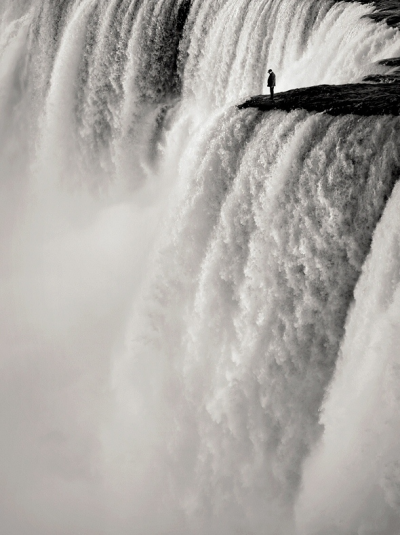
Existentialism is compatible with nihilism in that an existentialist is born a nihilist and reborn an existentialist. The nihilist stares into the void, and as Nietzsche said, “the void stares back.” She perceives a groundless ground resting on nothing – everything from nothing – a relativising void. This is Absolute Terror. She stares it in the face, that great impenetrable darkness, and screams, “My god, my god, why have you forsaken me?” But soon death’s prick, the experience of crucifixion, takes its toll, and the individual is left either dead or miraculously surviving. And at this point she is able to stare death in the face still and yet say,
“O Death, where is thy sting? O Grave, where are your inhabitants? Either they are forever asleep and have forgotten you totally, or they have vacated your empty stomach and you are left to starve. Your victory is empty and untenable.” At this point, having survived the void of death, the nihilist has gone through the cruciform cocoon and is emerging in an existential rebirth.
This rebirth is the resurrection event. The void that once rendered meaning arbitrary and illusive has been occupied by the subjective individual, rendered an object, and thus becomes a new ground for creativity. At this point the existential individual is ready to create meaning anew. Thus the creative act is born, and the individual is able to fly over the void on the wings of creative balance. This is Absolute Freedom.
Part of this existential maturity is the recognition that the impenetrable darkness perceived to be a void, an abyss of meaninglessness and soulless emptiness, cannot be confirmed as such. In fact, it may be that the darkness is the blindness that results as a consequence to an overexposure to infinite light. It may be that the dark cloud called “void,” this ineffable mystery that tears apart humanly-constructed meaning, is the sea of reality so deep and so wide that it cannot be contained and thus utterly fills every crevice while pouring over and absolutely transcending. Absolute Terror and Absolute Freedom are one. Thus the existentialist never really stepped into an abyss at all, but a sea so full that the creative act is not a god-act, but the rearranging of some materials in an infinite ocean, a form of human reductionism.
In a way, this non-god-act of dust from dust is still divine creativity. It is still a type of god-act. At the beginning of Genesis, our most popular creation story, a sea covers the earth and the spirit of the Divine sweeps over it. From this sea arises and manifests ground and land and earth and animal. Thus God creates from already existing materials, placing things in order through three acts of separation and three acts of filling:
Separation Filling
Day 1: light from dark = Day 4: light into sun and day, dark into night
Day 2: water above and water below = Day 5: fish into water and birds into sky
Day 3: land from sea = Day 6: vegetation and animals into land
And so we see that in this story, creation takes place through organization and emergence. Thus the true existentialist takes part in the creative act of emergence and organization and re-emergence and reorganization. When the flood comes up again from that deep sea called Mystery, she sails it until she finds dry land and starts again if need be. She sails the current of evolution as reality reorganizes and re-emerges, recognizing both potential and finitude, subject to that great current against which she cannot ultimately stand, but which she will one day join again.
No comments:
Post a Comment